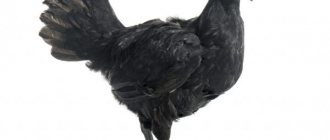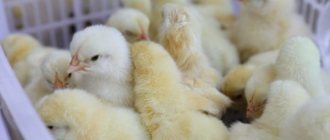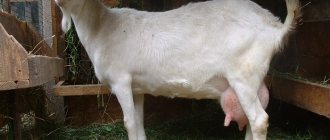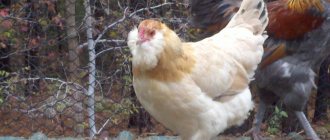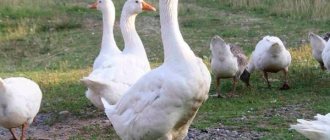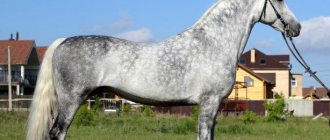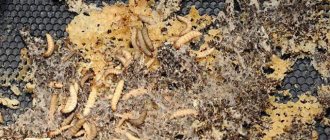Home » Articles about chickens » Borkovsky breed of chickens
In 2005, Ukrainian breeders registered the Borkovsky breed of chickens. Its distinctive features: good adaptability to unfavorable environmental conditions, high egg production, strong immunity.
Description of the breed
Selection work was carried out in the village of Borki (Kharkov region). When breeding Borkovsky chickens, leghorns with different plumage colors were used. Main characteristics of the bred breed:
- strong body, straight back, short neck, small head (simple, leaf-shaped comb);
- “cuckoo” color (the breast can be completely or partially monochromatic) – red, white, and red colors are less common;
- tail of medium length, fluffy (in cockerels - with black rings);
- the wings are well developed, they fit snugly to the body;
- yellowish skin;
- strong paws.
Since Borkovsky barvy chickens are not a cross, they can be bred within the flock. Chickens of this breed are considered good hens; they take care of their offspring. The survival rate of chickens up to 2 months is in the range of 94-95%.
Chickens lay eggs all year round, except during the molting period. Birds have a calm character. They can be kept in separate cages or in a chicken coop (with walking).
Characteristic diseases
It is believed that adult chickens of the Borkovskaya Barvistaya breed have no health problems. But if the requirements for their maintenance and nutrition are violated, the condition of the hens may worsen. This is especially pronounced during the period of most active egg laying.
Borkovsky barvy chickens are distinguished by a strong immune system, capable of coping with various pathogens that attack them.
If the usual conditions of detention are violated and the chickens eat irregularly, they become weaker. Young laying hens at the peak stage of laying can suffer from vitamin deficiency. It is necessary to recognize the disease in a timely manner in order to use drugs added to the feed that are suitable for treatment. For example, ascorbic acid, Trivit.
Productivity
The breed's orientation is egg-like. Sexual maturity occurs at 4.5-5 months. During the first years, each hen brings up to 265 eggs weighing about 55-65 g (the shells of the eggs are beige or white); in the third year of life, egg productivity decreases.
In accordance with the reviews of the owners, the Borkov barvy breed of chickens has good meat productivity - the weight of adult chickens reaches 1.7-1.9 kg, roosters - 2.4-2.5 kg. The meat is tasty and lean. The skeleton is light.
The nuances of breeding Ukrainian laying hens
This breed is popular not only in its homeland, it is also valued by Russian farmers. It attracts poultry farmers with its unpretentiousness, adaptive qualities and high productivity. The Borkovsky barvy laying hen is also good because it can be bred at home, since it is not a hybrid, but a full-fledged breed.
Puberty in pullets occurs at 4 months, but eggs for incubation are taken from individuals who have reached the age of nine months. By this time, laying hens have reached their full potential, and it is easy to choose the most productive among them. To hatch chickens, you can use 2-3 hens, which are not very productive, but readily lay eggs.
Reference. Some farmers prefer to hatch young animals in an incubator so as not to distract the laying hens from their main mission - to supply the farm with egg products. True, in this case, the survival rate of chicks decreases from 96 to 90%.
The chicks are born after 21 days, weighing 43–45 g. They can be sorted by gender at one day of age. Cockerels have light gray, smoky down color, while hens have darker down color, plus there are stripes on the back. Both males and females have a white spot on their heads.
Borkovsky chickens
Caring for young animals
The first food, a boiled egg, is given to chickens 10 hours after they hatch. Feeding is done every 2–2.5 hours. On the second day, you can add green onions and steamed millet. Next, it is recommended to transfer the chicks to compound feed for chickens of egg breeds, then they will receive everything they need for health and proper development.
Content
The Borkovsky barvy (colored) breed of chickens is well adapted to cold climates, so the need for additional heating of the chicken coop usually does not arise (it is only necessary in cold northern regions). An important condition is high-quality insulation - the cracks are sealed, the possibility of drafts is excluded, a deep layer of peat or sawdust is placed on the floor - only the top contaminated material is changed. The thickness of the layer in winter is about 25-30 cm.
Since the bird is light in weight, perches for it are arranged in several tiers. Containers with an ash-sand mixture for dry bathing are installed in the room (feed sulfur is added to the mixture - 50 g/3 kg). Nests are placed in shaded, secluded places (1 piece/3-4 individuals).
The optimal length of daylight in the cold season is 12-14 hours. Illumination is organized using incandescent, LED, energy-saving or fluorescent lamps (1 W/sq.m). The intensity of illumination depends on the zone: about 60 lux near feeders and drinkers, up to 1 lux at the location of the nests.
The walking area is arranged on the side of the chicken coop protected from northern winds. The area is sown with grass, which provides the chickens with additional green food.
Puberty and egg production
After five months, Borkovsky chickens reach sexual maturity. By this time, barby laying hens begin to lay their first eggs. This sets them apart from other egg-type breeds.
With proper care, the laying hen will show excellent results for four years, laying from 250 to 270 eggs each year. It is worth noting that this performance can be increased by 14 hours of daylight and a diet rich in protein and calcium.
The ability to lay eggs is not interrupted even in winter. A decrease in egg production is observed during plumage change. More on this below.
Medium-sized eggs are distinguished by a high content of highly digestible protein, weighing up to 55 g. The shell is white-cream in color.
Females are kept until the age of four, after which a decrease in performance occurs. You can begin the planned renewal of the herd.
As follows from practice, it is best not to delay the replacement of chickens, but to begin doing this in stages, first of all paying attention to birds that have reached two years of age.
Diet of adults
Up to 75% of the diet should come from grains. The priority is wheat, corn, barley. Up to 15% of the grain mixture is oats. Meal, cake, rye, buckwheat porridge, legumes, sunflower seeds are added to dry food (up to 10% in total). Poultry receives vitamins from fresh grass, fish oil, silage, feed yeast, and vegetables. In winter they give dry grass and pine needles.
Protein supplements play an important role in the diet - poultry is given crushed fish and meat waste and fermented milk products. We must not forget about minerals - they are contained in meat and bone meal, ground eggshells, limestone, shells, and table salt.
In addition to the dry grain mixture, chickens are given wet mash - they are prepared from the following ingredients:
- bran;
- grass;
- grain mixture;
- grated root vegetables and melons;
- yeast, cake, meal;
- chalk;
- salt;
- fish fat;
- fermented milk components;
- water or broth (fish, meat).
Wet food should be crumbly, it is prepared in such a way that everything is eaten in half an hour - this product cannot be stored. It is given in the first half of the day, and in the evening the chickens are fed grain.
In the poultry house, containers with small pebbles are placed next to the feeders - the chickens swallow fine crushed stone (3 mm), which helps grind the food in the muscular stomach (when the muscles contract, grinding of solid particles occurs). Separate feeders are used for different types of feed. The birds are provided with fresh, clean water.
Catering for adult chickens
Basic Rules
From the very beginning, the diet has a major influence on the development and growth of Borkovsky barvy breed chickens.
The chicken does not have teeth, so for the normal digestive process it needs small pebbles that help in grinding the food that enters the stomach.
It is best to equip the place intended for feeding with a separate container into which grated shells or chalk are poured. Near the chicken feeders there are drinking bowls filled with clean water, since chickens need a lot of moisture, especially in the hot summer.
When feeding Borkovsky barvy chickens, you must adhere to a diet suitable for egg-laying chicken breeds.
Diet
The best option is considered to be special combined feeds intended for egg breeds. It is with their help that the maximum productivity of laying hens is achieved.
But chickens of the Borkovskaya barvystaya breed also make do with cheaper feed - boiled potatoes, to which are added greens and grated vegetables, and grain mixtures.
It is recommended to add fish or meat and bone meal to the feed in small quantities (no more than 5% of the total feed). If a bird is planned to be slaughtered, they stop giving it flour a month before the event. Otherwise, the taste of the meat will be spoiled.
Grain is the basis of the diet of adult Borkov barvy chickens at any time of the year. With the onset of the spring-summer period, it is allowed to reduce the grain mass slightly, focusing on green feed.
In addition, the grains must be varied, containing in the overall complex everything that is necessary for the normal functioning of the chickens’ body. Ready-made mixtures are suitable for this. You can prepare them yourself using grains of corn, oats, wheat and rye.
Breeding young animals
Chicks can be obtained by placing hatching material in an incubator or placing it under chickens (Bork's are considered good brood hens). In any case, eggs are checked before laying to ensure that defective eggs (chipped, with limescale build-ups on the shell) do not enter the batch. Internal defects are detected using an ovoscope.
In the first month of life, chicks are very sensitive to temperature changes - they cannot be kept even at room temperature. From days 1 to 5 inclusive, the temperature is maintained at +29…+30°C. Then it is reduced by 3°C at weekly intervals, gradually bringing it to +18°C. Infrared lamps are used to heat the young animals. Until the 20th day, the duration of illumination is 24 hours a day, then it is gradually reduced, reaching 17 hours by the age of 40 days.
Reviews
Among the characteristics of the breed, breeders highlight their frost resistance, as well as the high productivity of laying hens. Chickens lay large eggs with a strong shell. The popularity of Borkovsky barvysta, according to reviews from farmers, is also due to its unpretentiousness in care and the absence of the need to purchase any specialized feed. However, birds provide small amounts of meat.
To learn about the characteristics of the Borkovskaya Barvistaya chicken breed, see the following video.
Determining the sex of chicks
One of the features of the Borkovskaya Barvistaya chicken breed is autosex. The sex of chicks can be determined by their color already in the first days of life. Females are dark gray in color, have dark stripes on their backs, and a small light spot on their head. Males are noticeably lighter.
To increase feed conversion, increase livestock safety and improve productivity, it is recommended to keep roosters and hens separately from each other. The bulk of cockerels are raised for meat - well-developed individuals that fully meet the breed characteristics are left for breeding (1 per 10 hens).
Standard requirements and rejection
The weight of a rooster reaches 2.7 kg, a chicken – 2.1 kg. The bird is distinguished by a thin neck, an elongated body with a flat back, a developed and full belly (in chickens), and a muscular, protruding chest (in roosters).
Laying hens' thighs and drumsticks are relatively small, the chest is inexpressive, which is a characteristic difference between breeds raised for eggs.
Chickens with a non-standard or too dark color, disproportionate or heavy, meaty body, or high-set tail are not allowed for breeding and are rejected.
If there are too many cockerels among the chickens, then the most aggressive ones are separated and fed until they are one year old for meat, leaving one leader for every ten hens.
Feeding the chickens
Immediately after birth, the chicks are fed at intervals of 2 hours - this regime is observed for 10 days. During this period, hard-boiled crushed eggs and crumbly low-fat cottage cheese mixed with small cereals (semolina, corn) are given. Optimal proportions for 10 chickens: 50 g of cereal and cottage cheese, 1 egg. You can give chicken feed, ground rolled oats with dry milk (a crushed multivitamin tablet is added to the mixture - 1 piece/10 chickens).
Greens are added to the diet from 3-5 days (they are finely chopped). From the age of one week, chicks are given wet mash with fish/meat broth or yogurt. From this age it is already possible to include meat and fish waste in the diet (up to 7 g per 1 chick).
At 10 days of age, the turn of vegetables comes (grated carrots, boiled potatoes, zucchini, and pumpkin will benefit the growing body). To avoid problems with digestion, the chicks are given whey, kefir, and yogurt in the morning. Boiled, crushed eggshells and crushed chalk are poured into separate feeders. Chickens, like adults, require fine gravel (as an option: coarse clean sand) to grind food in the stomach.
Advantages and disadvantages
A breeder planning to keep a bird of this breed should take into account its strengths and weaknesses. The advantages are as follows:
- chickens stand out among other breeds for their egg production;
- barvy very quickly gets used to a new place and conditions, which facilitates the adaptation process and eliminates problems with productivity;
- birds are immune to most diseases;
- chickens and roosters can live quite a long time;
- care and maintenance of this breed do not require the breeder to create any specific conditions;
- It is worth highlighting the good quality of feathers and down of the Bark bird, they can be used for making bedding;
- chickens enter the maturity phase early.
Among the weaknesses it should be noted:
- since the breed is still focused on producing eggs, the meat yield from one carcass will be low;
- The birds are quite noisy when kept.
Health of Borkovsky chickens
Under the right conditions, birds rarely get sick. Hens and roosters of the Borkovskaya Barvistaya breed do not have genetic diseases, but may suffer from parasites and some infections.
INTERESTING! The survival rate of chickens reaches 97%.
Frequent diseases of the breed
We present a table with common diseases of Borkovskaya barvistaya chickens.
| Name | Course and symptoms | Drugs and treatment |
| Pullorosis | Chickens drink greedily, refuse to eat, and droop their wings. The stool becomes foamy and yellow. | Furazolidone, Biomycin |
| Colibacillosis | The chickens are breathing heavily and refusing to eat. There is diarrhea and lethargy. | Terramycin, Biomycin, Ampicillin |
| Newcastle disease | The bird's coordination is impaired, its crest turns blue, and mucus flows from its nose. | There is no treatment, sick chickens are destroyed |
| Chicken pox | Characteristic yellow growths appear on the earrings and comb. The chickens are breathing heavily. | Treatment of affected areas with Furacilin solution |
| Helminthiasis | The bird experiences diarrhea and weight loss with a good appetite. | Alben, Levamisole, Fenbendazole |
| Gastroenteritis | Chickens have green foamy diarrhea, fever, and poor appetite. | Antibiotics and laxatives for bowel cleansing |
| Cloacite | The mucous membrane of the cloaca becomes inflamed, laying hens lose weight and reduce egg production. | Rinse the mucous membrane with Rivanol, treat with Vaseline with the addition of Terramycin |
| Keratoconjunctivitis | The bird's eyes water, the feather becomes dirty and wet. | Airing and washing the eyes with chamomile decoction |
| Pere-eaters | Chickens are itchy and worried. When a bird is heavily infested, its feathers fall out. | Aerosols Insectol and Arpalit |
IMPORTANT! If there are any signs of discomfort, you should contact your veterinarian. The specialist will conduct an examination and prescribe a treatment regimen.
Disease Prevention
To prevent diseases, once every 30 days, birds are given the following medications:
- weak pale pink solution of potassium permanganate. It is left for the bird for several hours;
- Levomycetin solution (1 tablet per 5 liters of water);
- To prevent coccidiosis, birds are given water with copper sulfate (3 tsp per 1.5 liters of liquid).
To prevent infection of Borkovsky barvises by helminths, you can feed the bird with a decoction of wormwood. To prepare it, add a tablespoon of dried herb to 500 ml of water and cook for 15 minutes.
Possibility of independent breeding
How to breed offspring
A chicken of the Borkovskaya barvy breed can become a good hen and mother, which saves poultry farmers from the need to use an incubator or look for a hen of a different chicken variety.
Even a novice poultry farmer can breed offspring of this breed. In addition, it has been practically proven that due to natural brooding, the survival rate of Borkova barvy breed chickens increases.
It is believed that Borkovsky barvy chicks are distinguished by their extraordinary resilience. Of the entire generation, up to 5% will die if the rules of feeding and care are strictly followed.
Chick weight and sex
The chicks that are born are not large in size - on the first day of life their weight does not exceed 45 g. The bodies are tiny, covered with grayish fluff with white or brown splashes.
In terms of growth, the chicks of the Borkovskaya Barvistaya breed do not differ in speed, but they accumulate mass confidently, quickly fledge and join the adult flock.
Sex separation occurs when it becomes possible to determine the sex of the chicks. Cockerels are pugnacity, and they require more food.
Care in the first days
In order for the offspring of Borkovskaya Barvistaya chickens to grow healthy and strong and to develop normally, it is recommended to create an appropriate diet.
